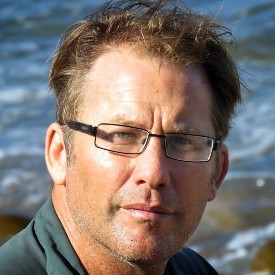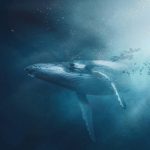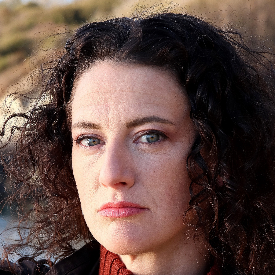Craig Foster is an author, filmmaker, and founder of the ocean conservation organization Sea Change Project. He was the subject, photographer, and director for the Academy Award-winning film My Octopus Teacher. He is passionate about marine animals, human origins, and indigenous knowledge.
Below, Craig shares five key insights from his new book, Amphibious Soul: Finding the Wild in a Tame World. Listen to the audio version—read by Craig himself—in the Next Big Idea App.

1. The wild is a miraculous healer.
When I returned to the Cape of Good Hope, I was in deep need of healing. Twenty-five years of filming on the road has been hard on my body. I’d spent weeks in hospitals, ill from parasites picked up diving in the lakes of Malawi and Rwanda, and almost dead from cerebral malaria. Though I healed from those conditions, my immune system was still weak, and I was prone to frequent chest infections.
Each time in my life when I’ve been most worn down, I’ve felt a deep pull to spend time connecting with nature. If anything could heal me, it was nature. The cold water of the sea forest was a great healer and a patient teacher, so taking my time and watching how my body responded was key. I started with short dives, then increased my time bit by bit. The cold immersions eventually supercharged my immune system, so I was no longer plagued with frequent chest infections. The cold had nursed me back to health and brought with it a new sense of clarity and peace. As with any intoxicating substance, I’ve learned I must treat the cold with respect. However, the benefits are undeniable and have inspired me to reflect upon the costs of comfort. What happens when society embraces a climate-controlled existence over an invigorating icy plunge? Can we learn to sit with our discomfort a bit longer? What insights await us on the other side?
Our aversion to discomfort causes us to miss out on so much. After all, the pain is fleeting, and what lies on the other side of those first three minutes of feeling cold is a lifetime of wonder and discovery.
2. We can all learn to speak humanity’s oldest language.
Before my return to the ocean, I spent decades learning from the greatest land trackers in the world—skilled hunters and naturalists from Africa’s indigenous hunter-gatherer cultures. During my time learning from the sand trackers of the Kalahari, I’d look at a paw print and perhaps be able to identify the difference between a primate and a big cat. However, a master tracker like !Nqate Xqamxebe or Karoha Langwane could tell me how long it had been since the animal had passed, which direction it was going in, and how much energy it had left.
!Nqate once shared with me how he could sense the presence of unseen animals in different parts of his body. He could feel the gemsbok, the lion, the leopard, the porcupine, as itching, as heat rippling through his legs, back, and chest. His body was a radar system tuned like an instrument to the animals he loved and tracked. I hoped I might use the teachings of these skilled trackers to develop my own method for tracking underwater, but I wasn’t sure how. Underwater, animal tracks are swept away in milliseconds, sound moves differently, the smell is impossible for humans, and even on the clearest mornings, you can’t see farther than a few feet away.
“Developing a personal tracking practice is something anyone can do, even if they live in a city.”
Then one day, I saw it. Sand stuck to a little trail of sticky slime that told me a sea snail had just walked this path. This was my first underwater track, many more would follow, each deepening my connection to the marvelous creatures who call the sea forest home.
Developing a personal tracking practice is something anyone can do, even if they live in a city. The secret is persistence—returning to the same spots over and over again sharpens pattern recognition skills until the paw prints and bird calls become a language you can speak. Following signs and tracks, using alarm calls and smells to find animals or avoid predators, is what humanity has done since the beginning. When we track, we feel alive, we feel present, we feel useful. We reignite something that has blazed inside us since the beginning of time. !Nqate Xqamxebe once told me, “Tracking is like talking with God.” This ancient art is a form of communication with nature that allows us to swim beneath the veil and pluck the stories of wild creatures to the surface.
3. Reconnecting to the wild is the antidote to burnout.
Before my return to the Cape of Good Hope, my life had been cluttered, my to-do list bulging and spilling black sludge. I needed time. Time to be without doing, time to allow my conscious mind to be quiet, remember who I was, and remember I wasn’t alone.
I have met so many people who yearn to connect with the natural world and understand its healing wisdom. Like me, many are grappling with depression and burnout, struggling to find meaning in a world where so much emphasis is put on amassing material wealth, frequently at the cost of the health of the natural world.
The tame world can distort our priorities, leading us to place too much importance on gratifying our egos. However, in cultures that respect their connection to the wild, no one individual is more important than any other. When a sand hunter brings a big animal home to feed the village, the people tease him, ‘Why did you even bother? Why’d you bring us this old bag of bones?’ They do this because they know the ego is a dangerous thing. When our tame-world egos and desires grow too big, we begin to fight with one another, and we devour our own home, our Mother, our sanctuary. Like many parents, I worry for my child’s future. But when I slip into the green-blue water or walk a wild shore, I feel a deep excitement that soothes my mind.
“The tame world can distort our priorities, leading us to place too much importance on gratifying our egos.”
In the water, wild animals have been my greatest teachers. I lie still, keep my body relaxed, and sometimes wait for days, weeks, months, or years. I do this every day, and then, suddenly, all the dots line up; it’s like a looking glass into a secret world. I’m inside of wild nature, speaking in the old way, my whole being is lit up and sparkling. It feels like my whole ecosystem is woven into the natural world, woven by water.
The animals teach me how to move my body, reduce my pressure waves, and not trigger the delicate alarm systems in the sea forest. They teach me to relax every muscle, as many animals can measure that muscle tension. They teach me not to kick up sediment, but they also teach me empathy and patience. They teach me deep love for my big Mother, nature herself.
They teach a sense of community, and they teach me not to scare the little guys who tell the big sharks to wake up. They teach me to flow with the force of the water, to be so grateful for life, to feel intense joy, to feel that I’m made of the same stuff as them, and to feel part of my mother. Above all, they help me remember who I am and to be grateful for the life force of the natural world that rejuvenates and heals us.
4. We can befriend our primal fears.
My desire to be close to the wild has always beaten out my primal fears of things like dark caves, rough waters, and dangerous predators. For me, managing fear is all about getting to know whatever it is you’re afraid of, as well as getting to know your limits. After all, most fear is of the unknown.
Get to the root of some of our species’ most common fears, and you’ll find intelligence there—a brilliant survival mechanism that helps wild people and animals survive. Consider a fear of deep water; the sea can be very dangerous, so there is wisdom in approaching with caution. Once you understand her ebbs and flows, however, you can make decisions that factor in the force of the wind and tides, the temperature of the air and water, as well as your own strength and energy levels.
We can’t chase our primal fears away or deny them any more than we can stop the waves from crashing against the shore or tell a cat not to hiss when her tail is caught under a branch. However, we can befriend the primal mind and speak to it the way you might your beloved dog who barks at a visitor. Now, if I feel my heart start to race when I enter the dark, cold water, I will scan my surroundings to make sure there are no real threats. Once I see that there are none, I say to myself, Thank you, but there is nothing to worry about today. This is a way of speaking across time to our ancestors, who knew perils we will never know, but who also knew a kind of life that our tame modern world has tried to snuff out.
I’ve had the privilege of working alongside scientists who’ve spent their lives studying our deep ancestors. Our coast is one of the world’s greatest hotspots for Middle Stone Age archeology. Here, I’ve photographed the oldest art and science on earth and learned a deep sense of our forebears’ lives. I’ve held the shells and bones, the remains of their last meals, from 100,000 years ago. I’ve sensed their joys and fears and drawn the courage to face my own fears. I marvel at the incredible path they have walked to bring us here today.
5. Wildness can be gentle and cooperative.
Over a decade spent nurturing my amphibious soul has given me confidence in humanity’s ability to build a society more in harmony with wild nature. This stands in contrast to a lot of the conversation around humanity, which seems to take as its premise that we are essentially a bad species—that we are violent and selfish and that only the veneer of civilization keeps us from killing one another.
The daily news certainly supports this idea, yet science, in many ways, may point to something quite different. Throughout all of the Middle Stone Age archaeology, little evidence points to interpersonal or intergroup violence. I have this strong sense that we come from a non-violent origin. It was only with the advent of agriculture that the reciprocity with the wild we’d enjoyed for some 300,000 years began to break apart and, with it, our psyches. The vibrant umbilical cord that connected our ancestors to the wild was severed, and this break has been traumatic.
“Our best space-age technology pales compared to the natural technology that allows an insect or bird to fly on a tiny drop of nectar.”
What happens when animals are traumatized? They often become violent. I think back to one encounter I had with a southern right whale. She lashed out when she felt trapped between us and a large rock. I also remember how the whale returned to me after the initial shock and was gentle, almost apologetic. Even under huge stress, humans, too, have the capacity to act from our gentle nature. While sometimes humans can be very cruel, I am always heartened when I think about global ecological justice efforts. So many human beings are recognizing we have an important role to play when it comes to answering the calls of our wild kin.
Our best space-age technology pales compared to the natural technology that allows an insect or bird to fly on a tiny drop of nectar. This ecological intelligence works hard to maintain itself, create biodiversity, and keep temperature and humidity within life-supporting limits.
Yet our childlike species today forgets what our ancestors knew well—that we are woven into this delicate balance and that biodiversity is our life support system.
Business and industry leaders, in particular, and the officials who support them, seem to have forgotten that the bedrock of their establishments is nature itself, that she allows their companies to function. Obsessed with short-term profit, they consume and plunder irreplaceable resources: our planet’s ancient forests, wetlands, wild rivers, and oceans. If biodiversity collapses, all their future investments will be worth nothing.
We stand on the shoulders of our deep ancestors, and this three million-year-old lineage of survival and deep reciprocity with nature gives me hope that we can remember who we are, re-unite with our original Mother, and regenerate our biological life support system.
To listen to the audio version read by author Craig Foster, download the Next Big Idea App today:
































